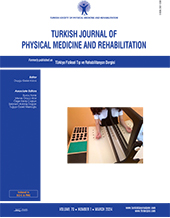Effect of diaphragmatic breathing training with visual biofeedback on respiratory function in patients with multiple rib fractures: A randomized-controlled study
2 Department of Physical Therapy, College of Health Science, Catholic University of Pusan, Republic of Korea DOI : 10.5606/tftrd.2024.12601 Objectives: The aim of this study was to investigate the effect of diaphragmatic breathing training with visual biofeedback on respiratory function in patients with multiple rib fractures.
Patients and methods: Between June 2021 and October 2021, a total of 16 patients (15 males, 1 female; mean age: 49.50±11.85 years; range, 25 to 66 years) who were diagnosed with multiple rib fractures were randomly assigned into two groups as the control group (CG, n=8) and the visual biofeedback group (VBG, n=8). The effect of each diaphragmatic breathing training on respiratory function was evaluated before and after eight interventions. For respiratory function, pulmonary function test was used to measure pulmonary function and respiratory muscle strength, and the Pain, Inspiratory capacity, Cough (PIC) score was used to evaluated pain, inspiratory capacity, and cough ability.
Results: In both groups, the pulmonary function representing the ratio of measurements to predicted values of both forced vital capacity (CG mean difference=25.37±4.58, p=0.002, VBG mean difference=24.25±3.96, p=0.007) and forced expiratory volume in 1 sec (CG mean difference=32.38±5.7, p=0.002, VBG mean difference=26.15±5.73, p<0.001) increased significantly. The maximal inspiratory (CG mean difference=14.00±0.35, p=0.002, VBG mean difference=20.5±6.26, p=0.009) and expiratory pressure (CG mean difference=43.72±29.44, p=0.034, VBG mean difference=25.76±6.78, p=0.015), the indicators of respiratory muscle strength, increased significantly in both groups. The PIC score, which evaluated pain, inspiratory capacity, and cough ability, also increased significantly in both groups (CG mean difference=1.63±0.26, p≤0.001, VBG mean difference=3.13±0.19, p<0.001). The change of PIC score after intervention did not significantly differ between the groups (F=1.439, p=0.250); however, there was a significant difference over time (F=38.476, p<0.001). The change of PIC scores differed over time between the groups (F=2.806 p=0.011).
Conclusion: Diaphragmatic breathing training and diaphragmatic breathing training with visual biofeedback can improve pulmonary function, respiratory muscle strength, pain, inspiratory capacity, and cough ability in patients with multiple rib fractures.
Keywords : Biofeedback, breathing exercises, diaphragm, respiratory muscles, rib fractures

















